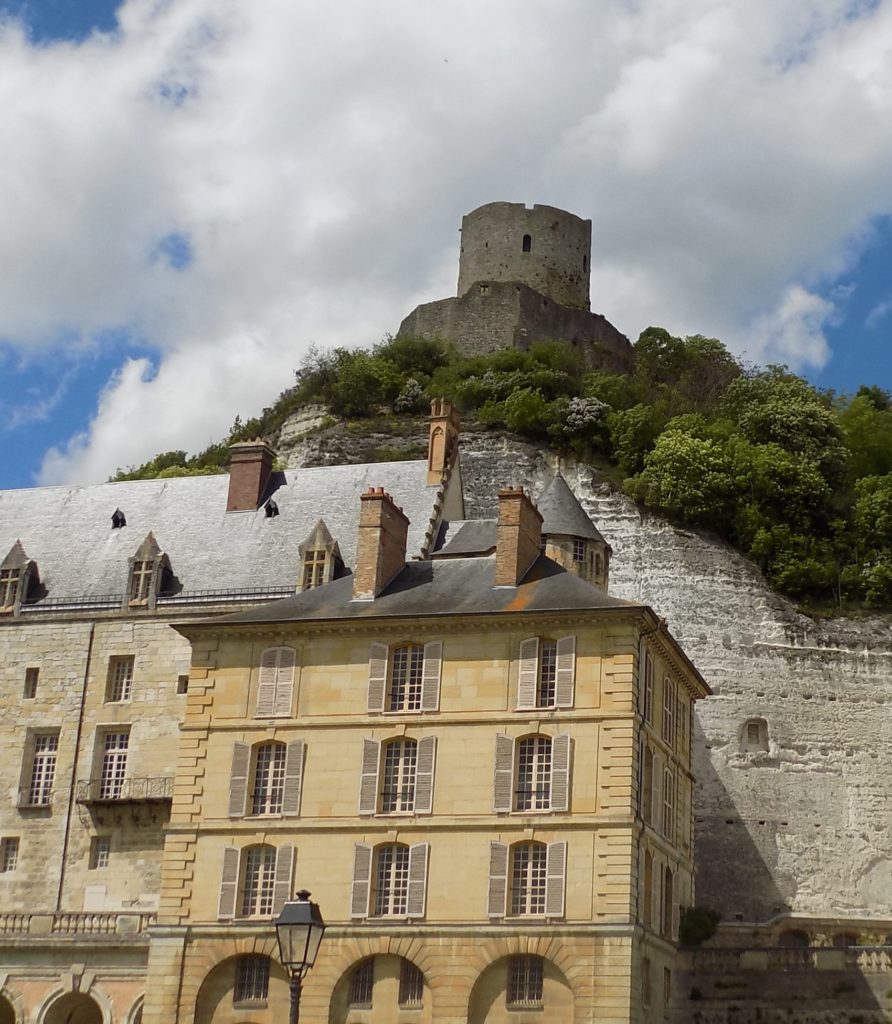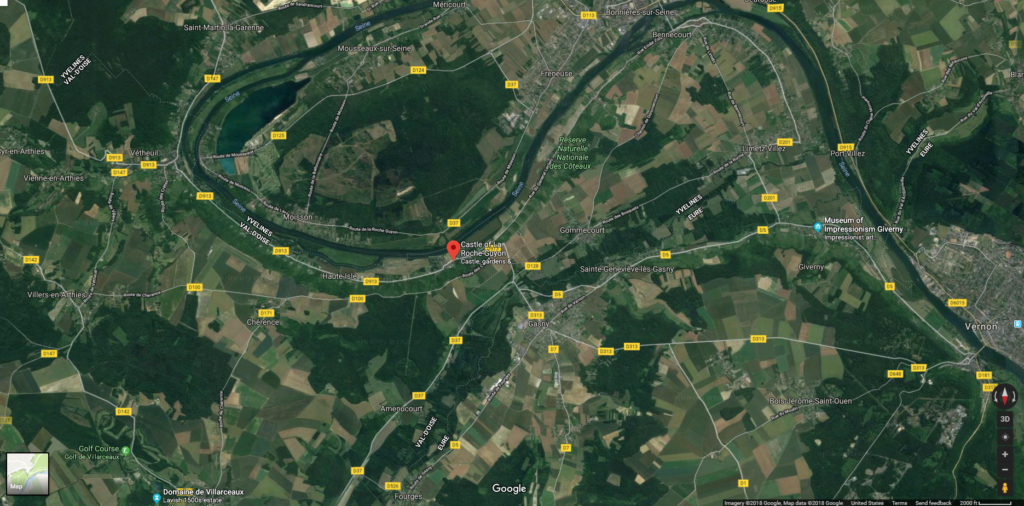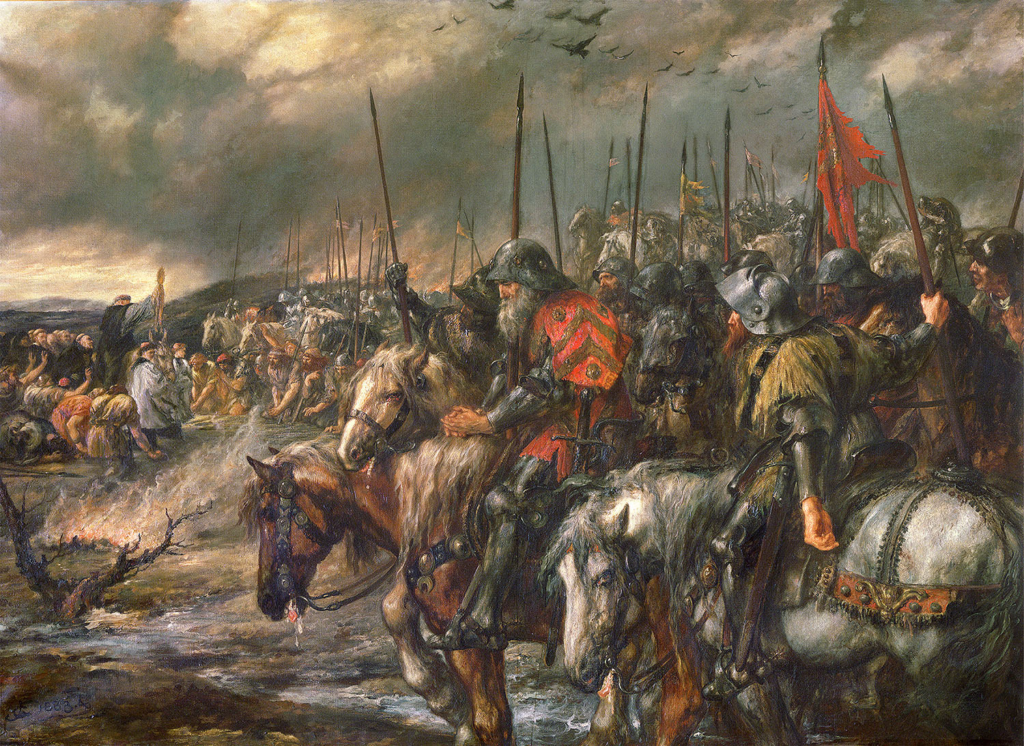As I noted in the previous post, I suspected the tour organizers included a visit to Château de la Roche-Guyon because of its role in the Second World War. The castle served as the headquarters for Field Marshal Erwin Rommel during his defense of Normandy from the allied assault that began on 6 June 1944 and since we had an all day excursion scheduled planned to visit the D-Day beaches this was a sensible prelude. However, before we get to Rommel, I’m going to provide a bit of the history of the castle. Are you surprised?
Let’s begin with the most notable – and quite possibly the most recognizable feature of the castle – the remnant of the original keep built in the 12th century
although if you look closely at the rock face behind the château-bas (lower castle) you can see evidence of construction in the hillside as well and this construction might be even older. The tower was erected in the 12th century but documents dating back as far as the 9th-century have led historians to conclude that the site was already fortified to try to provide some defense against Viking marauders who were repeatedly using the Seine as a riverine highway upriver to Paris.
The satellite view below from Google maps shows clearly why the site, sitting high above one of Sequana’s snaky bends is so strategically important. (Brave visitors with sufficient time can climb to the top of the keep. Still, if you take a close look at the satellite image from Google Maps below you should note that I rotated the map so north – the direction from which any marauders would come – is at the bottom and more or less toward the back of the keep as you see it in the first photo. As I’m sure you can imagine, a view from up there would allow a watchman to see ships a long way off.)
Controlling the bend in the river also allowed the collection of navigation fees for trading ships wanting to pass upstream. The sight of the tower today can be imposing so one can imagine why the Abbot known as Suger who lived from 1081-1151 and was one of the earliest and foremost proponents of Gothic architecture wrote of the castle, “At the summit of a steep promontory, dominating the bank of the great river Seine, rises a frightful castle without title to nobility, called La Roche. Invisible on the surface, it is hollowed out of a high cliff. The able hand of the builder has established in the mountainside, digging into the rock, an ample dwelling provided with a few miserable openings”.
His reference to the “castle without title to nobility” might be describing the vassals of the Comte de Meulan. Many of these early seigneurs were called Guy and this, of course, leads us to the name La Roche Guyon or, “The Rock of Guy.”
What’s a Hundred Years between such good Frenemies.
By the middle of the 13th century, the owners had added the fortified manor house below the original castle. The situation in this part of France remained relatively calm until the death of King Charles IV in 1328. In a previous post I noted that Charles died without a male heir and that in the immediate aftermath of his death, the crown passed to Philip from the house of Valois because he was the closest relative to Charles through male ancestry. Supporting this claim, the Avignon papacy had declared that under ancient Frankish civil law, males could not inherit through their mothers.
Edward III of England had just such a maternal inheritance and was, in fact, closer by blood to Charles IV than Philip. Still, as I hope you recall, initially, Edward recognized Philip’s claim and the latter became Philip VI, the first French king from the House of Valois. Edward, however, demanded that Philip promise not to interfere in any conflict England might have with Scotland (a traditional French ally) as a concession for his recognition of Philip’s claims. Philip agreed.
Unfortunately for the French, there was a small problem with Philip’s agreement and that was a treaty between France and Scotland known as the Auld Alliance and dating from 1295 agreeing that the French would come to Scotland’s aid if it was ever attacked. If you’re thinking, “I bet Edward had plans to attack Scotland,” you are spot on.
I won’t detail the political machinations that led to Philip’s decision on 24 May 1337 to reclaim the Duchy of Aquitaine but that became the last in a list of French actions that prompted Edward to challenge Philip’s claim to the French throne and this, in turn, led to the onset of the 116-year long Hundred Years War.
Those of you who are acquainted with Shakespeare’s history The Life of Henry the Fifth will have some familiarity with one of the most famous battles of the Hundred Years War, the Battle of Agincourt. It was one of the great English victories of that war and Shakespeare’s drama focuses on events immediately before and after that battle.
[Morning of the Battle of Agincourt 25 October 1415 – Painting by Sir John Gilbert – Image from Wikimedia – Public Domain.]
Its importance to the current narrative is that one of the casualties of the battle was Guy de la Roche. His death eventually led to the transfer of the property scowling down upon the Seine to Roger de Plessis-Liancourt – a childhood companion of Louis XIII and who was made a duke in 1643 – through his marriage to Marie de la Roche. Ownership passed again to the Rochefoucauld family when their daughter Jeanne-Charlotte de Plessis-Liancourt married François VII de La Rochefoucauld in 1669. Descendants of the La Rochefoucauld family occupy the castle to this day. (Those areas are not open to the public.) Now that you know a little of the history of the château, we’ll look at its role in World War II.
Rommel comes to la Roche-Guyon.
Unless one is writing an exhaustive history, the roots of an event, while not spreading as far as Pando, often run deeper and broader than any arbitrary starting point. (Pando is the quaking aspen in Utah with a root system estimated to weigh 6,000,000 kilograms and spread over 43 hectares.) Still, as I did in my posts about the battles at Greasy Grass (aka Little Bighorn), I have to choose a starting point and, in the case of Erwin Rommel coming to lead the German defense of the 1944 Allied assault on Normandy, that point is November 1943.
Through most of 1943, Hitler’s military attention was focused on two primary areas: the defense of Italy from the Allied assault that began in Sicily on 9 September; and his Eastern Front where he was fighting a war of attrition against the Soviet Union. (This strategy of sacrificing uncounted numbers of fighters was one that nearly every historical invader of Russia had encountered.) This left the defense of northwestern Europe toward the bottom of his priorities.
(The code name for the German invasion of the Soviet Union was Operation Barbarossa. The attack began on 22 July 1941 with an assault of 3,000,000 soldiers. Hitler’s plan assumed the German attack would overwhelm the Soviets in three to six months. While the earliest signs pointed to German success, the ferocity of the resistance created supply issues that, combined with the sheer numbers of Soviet troops, managed to stall the German advance long enough for “General Winter” as the Russians called their wartime weather to come to their aid.
The ferocity of the Soviet resistance increased with the issuance of two orders from the desk of Joseph Stalin. The first declared that any troops who surrendered or were even captured would be considered traitors to the state and the second, known as the “Not One Step Backward!” rule, declared that any troops who retreated were cowards who were to be “liquidated on the spot.” The Soviets organized so-called “blocking detachments” to enforce this policy. These troops were special units positioned behind their own lines and charged with shooting any soldier who tried to flee. Some reports claim that in enforcing Stalin’s decree the Soviets killed as many as 150,000 of their own soldiers.
Two and a half years after the onset of the planned six month invasion of Operation Barbarossa the German Army was still engaged in that war of attrition in the east – one that it was gradually losing.)
Note: In keeping with my 2022-2023 reformation of the blog into shorter entries, backdated to maintain their sequence, any comments on this post might pertain to its new configuration. See the full explanation in the post Conventions and Conversions.



I’m not sure if Tim is attacking the cello or aggressively courting it. Either way his performance was riveting. Thanks for sharing.
(insert obligatory food reference here) 😉
There will be some food discussion in the second Rouen post. Perhaps not precisely what you have in mind but tasty nevertheless.